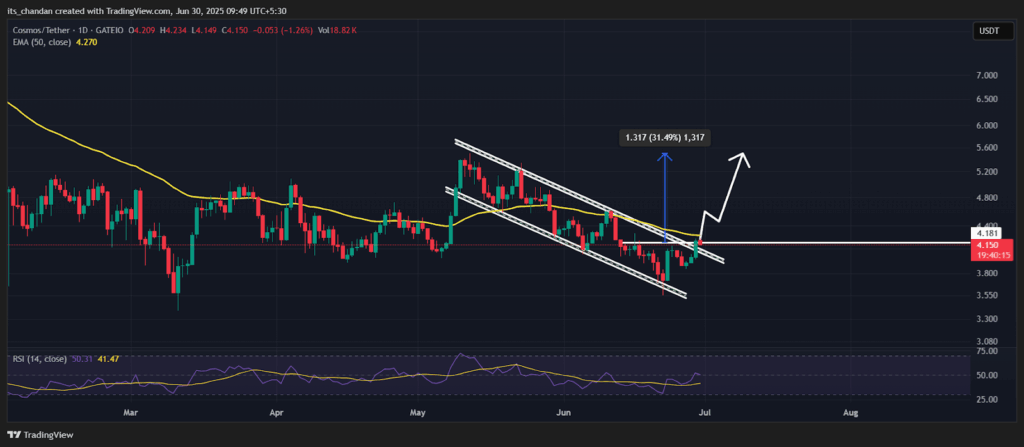Key Insights:
- On X, experts made bold predictions for Cosmos crypto, forecasting a price target of $17 for ATOM.
- Based on chart analysis, if ATOM breaks and holds above the resistance level of $4.18, it could rally by 31.50%.
ATOM, the native token of the Cosmos crypto, appears bullish and is poised for a significant upside rally due to its strong price action. The daily chart reveals that the asset has recorded a notable 15% rally over the past week and has reached a key level that is now garnering significant attention from experts and investors.
Experts’ Bold Prediction for Cosmos Crypto
Given the current market sentiment, several posts have surfaced on X (formerly Twitter), making bold predictions that are now gaining widespread attention.
In a recent post on X, a well-followed crypto expert made a bold prediction. In the post, he noted, “All I know is ATOM will go to 17 whenever it is ready. Thank you for your attention to this matter!”
This bold prediction by the expert reflects strong interest and confidence in the asset. Additionally, another crypto expert shared a bullish outlook for Cosmos crypto. In a post, the expert stated that technical analysis indicates a bullish trend and suggests that ATOM could soar in the coming days.
Meanwhile, another analyst shared a similar view. In a post on X, the expert noted, “ATOM was performing extremely well during the last bull run are now deeply oversold, and recovery seems nowhere near.
Considering the bullish comments and bold predictions for Cosmos crypto, it appears that ATOM has strong potential for upside momentum in the coming days.
Current Market Sentiment
At press time, Cosmos (ATOM) was trading near $4.04 and had recorded a modest upside rally of over 1.65% in the past 24 hours. However, during the same period, trader and investor participation has declined.
Data from CoinMarketCap reveals that ATOM’s trading volume during this period dropped by 8% compared to the previous day.
This drop in the trading volume suggests weak momentum in the Cosmos crypto and there is a strong possibility that the asset could struggle while continuing its upside momentum.
Cosmos (ATOM) Price Action and Price Prediction
According to expert technical analysis, ATOM has been hovering between the upper and lower boundaries of a descending channel pattern since May 2025.
However, with the recent upside momentum, the asset’s price has reached the upper boundary and appears to be struggling to break out of the pattern.

Cosmos Crypto Price Prediction
Based on recent price action and historical patterns, if the upside momentum continues and ATOM breaks out of the descending channel pattern, closing a daily candle above the $4.18 level, the bearish trend could come to an end.
If this happens, there is a strong possibility that Cosmos crypto could soar by 31.50%, with the price potentially reaching the $5.50 level in the coming days.
On the other hand, if sentiment shifts and the asset fails to breach the trendline, there is a strong possibility that Cosmos (ATOM) could continue its downward momentum, potentially repeating its historical pattern.
At press time, Cosmos crypto is facing resistance from the 50-day Exponential Moving Average (EMA), which suggests that the asset remains in a downtrend.
Whereas, ATOM’s Relative Strength Index (RSI) stands at 50, indicating a neutral momentum in the market, where neither buyers nor sellers have a clear advantage.
This suggests a period of consolidation, and the next price movement could depend on whether buying pressure builds up to push it above the key resistance levels or selling pressure drags it below immediate support.
